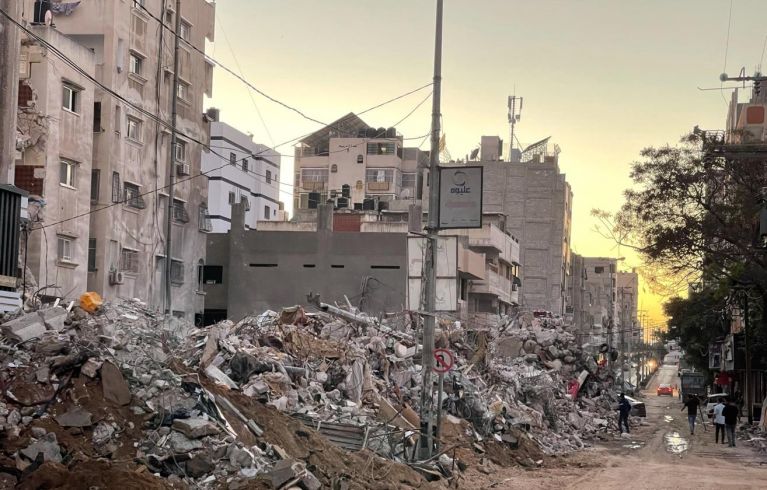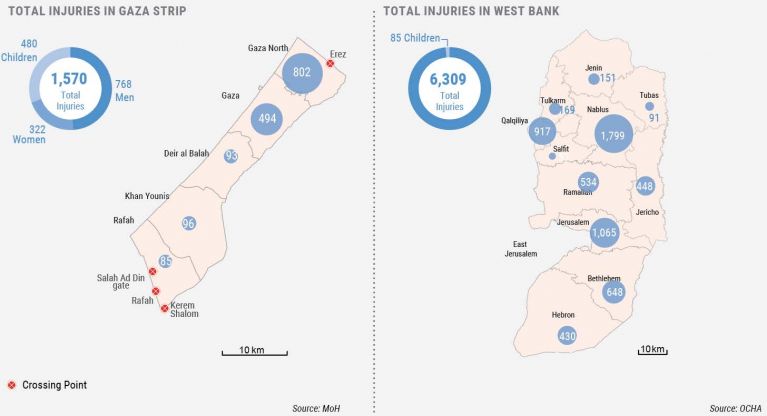Escalation in the Gaza Strip, the West Bank and Israel | Flash Update #9 covering 12:00 18 May – 12:00 19 May
- Hostilities between Israeli forces and armed groups in Gaza continued for the ninth day, albeit at a lesser intensity. In the last 24 hours, in the context of hostilities in Gaza, the Office of the High Commissioner of Human Rights (OHCHR) verified that six Palestinians were killed, including at least two civilians, one of whom was a girl.1
- Hostilities have also resulted in additional displacement of Palestinians, bringing the cumulative number of internally displaced persons (IDPs) to about 75,000, including 47,000 seeking protection in 58 UNRWA schools across Gaza. Another 28,700 displaced people are staying with host families.
- Clashes between Palestinians and Israeli forces across the West Bank, including in East Jerusalem, intensified. Three Palestinians were killed and 1,485 Palestinians were injured by Israeli forces.
- During the reporting period, two foreign nationals were killed in Israel from Palestinian fire.
- In a statement yesterday, the Under-Secretary-General for Humanitarian Affairs and Emergency Relief Coordinator, Mark Lowcock, called on “all parties to the hostilities to agree to a humanitarian pause to allow for emergency humanitarian relief distribution and for civilians to purchase food and water, seek medical care and attend to other emergency needs.”
Key asks
The fighting must stop immediately.
Until a ceasefire is reached, all parties must agree to a ‘humanitarian pause’, to ensure access into and out of Gaza for humanitarian staff and critical goods. This includes the creation of secure conditions so that the relevant crossings can be opened. Humanitarian Corridors inside Gaza must be agreed and respected to allow safe movement for the delivery of assistance.
Situation overview
Casualties: Gaza and Israel
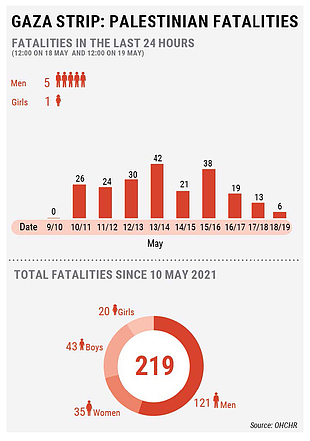 Overnight, Israeli forces carried out strikes from the air, the land and the sea across the Gaza Strip, reportedly targeting armed groups and related infrastructure, especially tunnels, and the residences of armed group members. A total of 1,810 airstrikes have reportedly been carried out by Israeli forces since the start of the escalation.
Overnight, Israeli forces carried out strikes from the air, the land and the sea across the Gaza Strip, reportedly targeting armed groups and related infrastructure, especially tunnels, and the residences of armed group members. A total of 1,810 airstrikes have reportedly been carried out by Israeli forces since the start of the escalation.
At about 4:00, on 19 May, the Israeli Air Force struck a five-storey building west of Gaza city, killing a 32-year-old journalist working with the Hamas-affiliated broadcaster Al Aqsa TV and Radio. Several nearby buildings sustained damage. Reportedly, the strike was preceded by a “roof-knocking warning”. According to OHCHR, the incident raises concerns with regard to respect for the principles of distinction and proportionality under international humanitarian law (IHL).
Under IHL, only attacks against objects which by their nature, location, purpose or use make an effective contribution to military action or whose destruction offers a definite military advantage are lawful. Targeting civilian objects, including governmental buildings, homes and civilian infrastructure is absolutely prohibited in any circumstances. Attacks against military objects expected to cause a disproportionate harm to civilians or civilian objects are also forbidden.
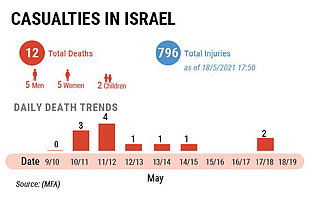 Since 10 May, OHCHR has verified that 219 Palestinians, including 63 children, 35 women (of whom three were pregnant) and 121 men, have been killed in Gaza. The overall number includes two people with disabilities, including a child. According to OHCHR, at least 121 of those killed are civilians.2 At least 208, including 60 children, were seemingly killed by Israeli forces. According to the Israeli authorities, some of the Palestinian casualties in Gaza may have resulted from Palestinian rockets falling short. At least 14 families in Gaza have lost three or more family members in the same incident, for a total of 66 fatalities.
Since 10 May, OHCHR has verified that 219 Palestinians, including 63 children, 35 women (of whom three were pregnant) and 121 men, have been killed in Gaza. The overall number includes two people with disabilities, including a child. According to OHCHR, at least 121 of those killed are civilians.2 At least 208, including 60 children, were seemingly killed by Israeli forces. According to the Israeli authorities, some of the Palestinian casualties in Gaza may have resulted from Palestinian rockets falling short. At least 14 families in Gaza have lost three or more family members in the same incident, for a total of 66 fatalities.
Palestinian armed groups have continued to fire rockets and mortars into Israel, with many intercepted by the ‘Iron Dome’ defence system, killing two more people on the afternoon of 18 May, both male foreign workers employed in an Israeli community close to the perimeter fence with Gaza. According to Israeli sources, between 10 May and 19:00 on 18 May, Palestinian armed groups in Gaza fired more than 3,500 rockets and other projectiles into Israel. By the end of the reporting period, twelve people, including one soldier, were killed by Palestinian rocket fire or when running for shelter during such strikes, and about eight hundred have been injured.
The indiscriminate launching of rockets and mortars towards densely populated areas in Israel is absolutely prohibited in any circumstances.
Gaza
Infrastructure and Services
Hostilities have further damaged essential infrastructure, resulting in an additional decline in public access to basic services across the Gaza Strip. According to the Ministry of Public Works and Housing, since the start of the escalation, 230 buildings, comprising 991 housing and commercial units, have been destroyed. In addition, 678 housing units have been severely damaged, and rendered uninhabitable, according to the Shelter Cluster. An additional 12,886 housing units have suffered minor damage.
The Education Cluster reports that 48 education facilities, including 44 schools, two kindergartens, an UNRWA vocational training centre, a Ministry of Education facility and the premises of the Islamic University have been damaged since the start of the escalation. All schools in Gaza, remain closed for the fourth consecutive day following the Eid holidays.
According to the Health Cluster, six hospitals and eleven primary healthcare centres have been damaged, with one centre suffering severe damage. One hospital is not functioning due to lack of electricity for the fourth successive day. As a result of the damage sustained by the central testing laboratory for COVID-19 during an Israeli airstrike on 17 May, all COVID-19 PCR testing has been suspended for the third successive day, except for those leaving for Egypt.
The Gaza Electricity Distribution Company (GEDCO) has reported additional damage to feeder lines and networks, with the average power supply still reduced to 3-4 hours a day throughout Gaza. Following the delivery of 500,000 litres of Egyptian imported fuel on 18 May, the Gaza Power Plant continues to operate on two out of four turbines, generating around 50 megawatts (MW) of electricity. The current electricity supply from all sources is about 107 MW, far short of the 400 MW needed in Gaza.
Water, sanitation and hygiene (WASH) facilities have been severely affected by the hostilities, with damage to more than 10,000-metres of underground sewage and water lines, as well as wastewater networks, sewage evacuation vehicles, wells and a wastewater pumping station. According to the WASH Cluster, due to lack of power supply, three main desalination plants providing services for more than 400,000 people have suspended operation and more than 100,000 cubic metres of untreated or partially treated wastewater are being discharged to the sea daily. The North Gaza Seawater Desalination Plant is still not operational, which undermines the access of about 250,000 people to drinking water. In total, an estimated 800,000 people are lacking regular access to safe piped water.
Displacement
According to UNRWA, as of the morning of 19 May, 47,000 internally displaced persons (IDPs) are seeking protection in 58 UNRWA schools, including in 23 designated emergency shelters (DES), still not officially open as such. Another 28,700 people are staying with host families according to the Ministry of Social Development (MoSD).
Using available resources, UNRWA is helping those seeking shelter in its schools, by providing potable water, sanitary facilities, and electricity during power outages through generators. Given the high density of IDPs in UNRWA schools, the provision of personal protective equipment remains a priority to prevent the spread of COVID-19.
Crossings
Despite indications that the Israeli authorities would allow a number of international staff to exit Gaza on 18 May, the Israeli-controlled Erez passenger crossing remained closed yesterday, reportedly due to Palestinian mortar fire towards the area of the crossing.
The same is true for the Israeli-controlled Kerem Shalom goods crossing, which temporarily opened on 18 May for the passage of humanitarian and commercial cargo. Insecurity at and near the crossing resulted in its premature closure to ensure the safety of drivers and crossing personnel. Only five of the 24 humanitarian trucks scheduled to cross managed to enter Gaza. Essential humanitarian cargo that was approved but was unable to cross included food, COVID-19 vaccines, first aid kits, medical disposables and drugs, including emergency medicines; as well as fire extinguishers and fuel, among other items.
The Rafah crossing with Egypt is open for passengers in both directions as normal. The flow of goods including food and fuel into Gaza through the crossing continued. The Israeli authorities continue to prohibit all fishing activity off the Gaza coast.
West Bank, including East Jerusalem
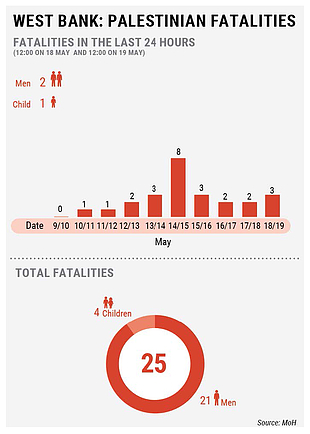 During the general strike on 18 May, which was widely observed, large scale protests took place across the West Bank, including East Jerusalem, to show solidarity with Palestinians in East Jerusalem and Gaza. Some protests led to clashes, which involved stone-throwing by Palestinians, and shooting of live ammunition, rubber bullets and tear gas and stun grenades by Israeli forces. Three Palestinians were killed and at least 1,485 others were injured, bringing the total number of deaths in the West Bank to 25 and the number of injuries to 6,309, since 10 May.
During the general strike on 18 May, which was widely observed, large scale protests took place across the West Bank, including East Jerusalem, to show solidarity with Palestinians in East Jerusalem and Gaza. Some protests led to clashes, which involved stone-throwing by Palestinians, and shooting of live ammunition, rubber bullets and tear gas and stun grenades by Israeli forces. Three Palestinians were killed and at least 1,485 others were injured, bringing the total number of deaths in the West Bank to 25 and the number of injuries to 6,309, since 10 May.
The three fatalities include two Palestinians shot and killed by Israeli forces at Beit El/DCO checkpoint outside of Ramallah, and a 16-yearold Palestinian boy who was shot and killed by Israeli forces in Bil’in village, west of Ramallah. All killings occurred during clashes with Israeli forces. Attacks against Palestinian Red Crescent Society (PRCS) medical teams were reported by cluster partners, including an ambulance struck by live ammunition from Israeli forces near Beit El/DCO checkpoint.
According to OHCHR, the opening of fire by Israeli forces in these fatal incidents raises concerns of excessive use of force. The use of potentially lethal force in law enforcing operations, including crowd control, is only allowed where there is a threat to life or of serious injury and even then, must be used in a manner which aims at minimizing harm and preserving life.
In East Jerusalem, Palestinians marched from Damascus Gate of the Old City to Sheikh Jarrah, in solidarity with the families at risk of eviction, where Israeli forces are still blocking the Al Jaouni area. Reportedly, Israeli forces physically assaulted and shot rubber bullets, tear gas and ‘skunk’ water at Palestinians, injuring 34 people, including 17 who were transferred to hospitals for treatment.
Notes
1. Includes those that have died during the past 24 hours due to injuries previously sustained.
2. Those reported as civilians are individuals who are not members of armed forces and were not directly participating in hostilities at the time that they were killed. Whether an individual is qualified as civilian or not, has no bearing on the legality of the killing. Data is based on information from at least three independent and reliable sources at the time of reporting. As further verified information becomes available, the number of fatalities in total, and in any of the categories, may change.
Humanitarian response & ongoing needs
Protection
Gaza: According to the Protection Cluster, there is growing psychological distress among those displaced by the ongoing hostilities, in addition to an increased risk of Explosive Remnants of War (ERW) contamination. Not all of the 12 Family Centres and 30 outreach sites supported by UNICEF are operational. On 18 May, the Gender-Based Violence (GBV) Sub-Cluster (SC) organized two mental health support group sessions for GBV frontline workers in Gaza, especially for counsellors. There are currently 92 trained and available psycho-social support (PSS) counsellors in Gaza, although 85 are not able to do their work, due to the current hostilities. Cluster partners are looking to increase the numbers of counsellors and put in place partnerships for remote counselling support. Between 11-16 May, Cluster partners provided remote MHPSS services through its national helpline to people in need of psychological first aid. A total of 348 recreational kits, estimated to reach 90 children, are in place in Gaza for distribution to designated emergency shelters (DES) once activated, in addition to 300 psycho-social kits (suitable for one family each) in the UNRWA Rafah warehouse. First aid kits are available and ready for distribution once security conditions improve.
West Bank, including East Jerusalem: Cluster partners are monitoring and documenting suspected violations and providing legal aid and child protection services, as well as mental health and psycho-social support (MHPSS). Of ongoing concern is the use of excessive force by Israeli forces as well as attacks by Israeli settlers and the use of live ammunition against Palestinians in particular. Cluster partners continue to provide remote MHPSS and legal aid for those detained. A total of 51 trained PSS counsellors are available in East Jerusalem, and Cluster partners are aiming to increase this number and expand further on possible partnerships for remote counselling support. Between 11 and 16 May, cluster partners provided remote MHPSS through its national helpline to people who need psychological first aid. UNRWA has produced a Live Ammunition Report focusing on the use of live ammunition in the West Bank, while Diakonia International Humanitarian Law Centre released a Legal Brief on resurging violence and hostilities.
Health
Gaza: The demand for emergency medical services is increasing, alongside the ongoing hostilities. The occupancy rate of Intensive Care Unit (ICU) beds, as of 10:00 on 19 May, stands at 41 per cent, with more than half of the cases resulting from armed conflict-related injuries, and 27 per cent from COVID-19related admissions. With the central testing laboratory for PCR COVID-19 testing damaged and not operating, health workers are heavily dependent on rapid antigen testing for diagnosing COVID-19 cases. Due to limited capacity, the Palestinian Medical Relief Society’s laboratory is providing PCR testing only those who need to travel to Egypt, as they are requested to present a negative COVID-19 test.
West Bank, including East Jerusalem: During the general strike on 18 May, emergency medical services and volunteers tended to injuries resulting from confrontations between Palestinian protestors and Israeli forces. Violations against Palestinian Red Crescent Society (PRCS) medical teams were reported by cluster partners, including an ambulance hit by live ammunition near Beit El/DCO checkpoint outside of Ramallah. Cluster partners are expressing grave concern over the use of live ammunition by Israeli forces, which places medical first responders at risk when tending to injuries. According to the Nablus Governorate, there is shortage of medical supplies and capacity in the main government hospitals and treatment centres, with the Ministry of Health (MoH) stock directed mainly to support Gaza.
Shelter
Gaza: According to the Ministry of Public Works and Housing, hostilities have resulted in 230 buildings destroyed, comprising 991 housing units and commercial facilities, in addition to 678 housing units with severe damage (uninhabitable) and 12,886 with minor damage. Partners are assessing the damages and supporting the repair of homes with major damage, giving priority to vulnerable groups. According to UNRWA, as of this morning, at least 47,000 people sought shelter in 58 UNRWA schools, including 23 designated emergency shelters (DES), still not officially open as such. Shelter partners have supported at least 512 affected families (2,048 people) with non-food items (NFIs), including bedding sets, hygiene kits and dignity items, although needs are constantly increasing. The Qatari Gaza Reconstruction Committee is providing cash to families with damaged homes (between US$1,000 and $2,000). The provision of cashvouchers to some 1,000 IDP families is coordinated with the Ministry of Social Development (MoSD).
Water, Sanitation and Hygiene (WASH)
Gaza: WASH infrastructure has been severely affected as a result of the hostilities. Due to power supply shortages, operations of three main desalination plants providing services to over 400,000 people have completely halted. The operation of wastewater treatment plants has been severely disrupted due to a shortage in power supply, resulting in the daily discharge of over 100,000 cubic metres of untreated or poorly treated sewage into the sea. According to the Ministry of Social Development (MoSD), over 2,000 IDPs at host families have limited access to WASH supplies and are in urgent need of hygiene materials and clean drinking water. PWA, CMWU and the WASH Cluster have developed a list of 109 WASH critical facilities most affected by the power shortages, which will be provided with 300,000 litres of emergency fuel to operate backup generators for one month. UNICEF and other cluster partners have started the supply of emergency fuel, and UNICEF has coordinated with the World Food Programme (WFP) to initiate an e-voucher programme to provide the most affected families with needed hygiene items and clean drinking water.
Education
Gaza: Some 50 education facilities, including 45 schools, have suffered damage and another 58 schools are being used as temporary shelters by displaced people. All schools are closed, and distance learning is not yet activated. Partners are scaling up remote MHPSS and the delivery of emergency education supplies to displaced children, and will start resource mobilization to rehabilitate damaged education facilities. The Education Cluster expects that education will not be provided, neither face-to-face, nor remotely while the hostilities are ongoing: families are overwhelmed with competing needs and many areas of Gaza are facing power-cuts.
West Bank, including East Jerusalem: On 19 May, the Ministry of Education (MoE), re-opened schools in the West Bank, including East Jerusalem, with the exception of schools in the H2 area of Hebron, central West Bank and other hotspot areas that will continue with remote and online learning modalities.
Food Security
Gaza: The Kerem Shalom crossing point operated for a few hours on 18 May, allowing the entry of about
120 ton of animal feed (1,000 tons originally planned). This supply is a fraction of the actual needs (about 600 tons of fodder per day), risking the disruption of the entire animal production sector. Some 17,000 households are at imminent risk of losing their livelihoods. The Ministry of Agriculture (MoA) have reported losses of 50,000 broilers and expects that an additional 10,000 birds will be lost, in addition to 30,000 litres of milk that is spoiled every day. Commercial stores in Khan Younis report that the current stocks of dairy products will be depleted in the coming five days. Farmers are unable to access their farms or markets, due to the security risks. The destruction of one of the largest agriculture inputs stores in the north of Gaza has caused a 50 per cent decrease in the availability of agricultural inputs. For the ninth day, there is a full closure of the sea, leading to the complete disruption of fishing activities and daily losses estimated at about US$ 100,000. The World Food Programme (WFP) has supported some 68,000 people affected by the ongoing crisis and continues to coordinate and prepare for additional support, including ready-to-eat food. This food assistance is crucial, as it allows families to cover their basic needs without having to go to the market during the ongoing hostilities.
